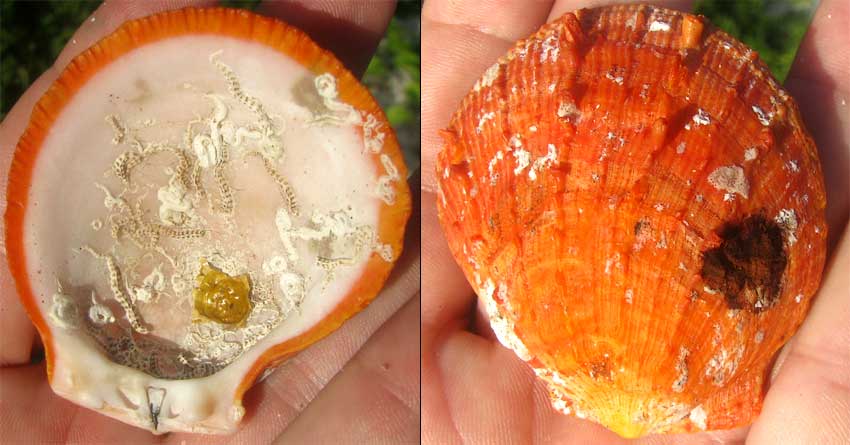Excerpts from Jim Conrad's
Naturalist Newsletter

from the September 11, 2011 Newsletter issued from Mayan Beach Garden Inn 20 kms north of Mahahual; Caribbean coastal beach and mangroves, ~N18.89°, ~W87.64°, Quintana Roo state, MÉXICO
DISCOVERING ABOUT THORNY OYSTERS
On the beach just beyond the waves I found a 2-inch- wide (5cm) seashell, both sides of which are shown above.
My first thought was how pretty the brightly orange-red shell looked lying atop the white sand, ornamented with those intricate and mysterious squiggles covering the shell's interior side, and those curious, toothlike growths atop the shell around the edges. But my next thought was that even after four solid months of beachcombing I remain so ignorant that I couldn't answer a child's simplest questions about what kind of shell it was.
I knew that the animal producing it was a bivalve, but that name applies to the whole "class" Bivalvia, which are mollusks with bodies protected by two hinged shells. Calling it a bivalve is like saying something is a bird (class Aves) or mammal (class Mammalia); it's not saying much.
The term "scallop" popped into mind. Scallops are marine bivalves of the Pecten Family, the Pectinidae. Scallops are eaten and often have brightly colored shells with radiating wavy patterns like ours. The shell design used by Shell Oil is based on a seashell known as the Giant Scallop, whose technical name is Pecten maximus. So, scallops and pectens are pretty much the same thing, and our shell looked a bit like the Shell Oil one.
On that basis alone I wasted several hours Googling for pictures of scallop and pecten shells looking like ours. I found shells very similar to ours, but none exactly the same.
And then along came volunteer identifier Bea in Ontario who declared our shell an oyster shell!
Until now I've visualized oyster shells as flattish, irregularly formed, mottled, brown and white, rather unkempt-looking things not at all like our shell. But Bea introduced me to the concept of the "thorny oyster" of the genus Spondylus. Lots of spondylus shells are brightly colored and ornamented with radiating ridges, bumps and spines, just like ours.
I'd run into that word "spondylus" before. As a kid I saw National Geographic pictures of Polynesians wearing spondylus shell necklaces, never dreaming that one day I'd find such shells myself. But now I read that people in many places have been picking up spondylus shells for a long time. Archaeological evidence indicates that as far back as 5,000 years ago Neolithic Europeans were trading shells of Spondylus gaederopus for making bangles and other ornaments.
There are lots of species of the genus Spondylus. Bea found a whole page of different species showcased at http://www.nmr-pics.nl/Spondylidae/album/.
I'm thinking that the Digitate Thorny Oyster, SPONDYLUS ICTERICUS, distributed in the western Atlantic from Florida and Bermuda to Brazil, comes the closest to ours. But that's the guess of a real seashell-identifying amateur.